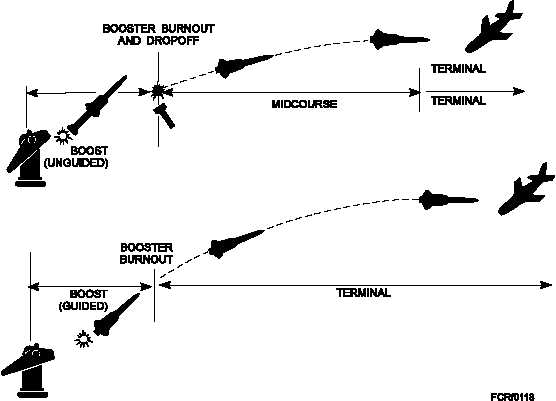computer. This establishes the line of fire (trajectory
or flight path) along which the missile must fly during
the boosted portion of its flight. At the end of the boost
period, the missile must be at a precalculated point.
There are several reasons why the boost phase is
important. If the missile is a homing missile, it must
“look” in a predetermined direction toward the target.
The fire control computer (on the ship) calculates this
predicted target position on the basis of where the
missile should be at the end of the boost period. Before
launch, this information is fed into the missile.
When a beam-riding missile reaches the end of its
boosted period, it must be in a position where it can be
captured by a radar guidance beam. If the missile does
not fly along the prescribed launching trajectory as
accurately as possible, it will not be in position to
acquire the radar guidance beam and continue its flight
to the target. The boost phase guidance system keeps
the missile heading exactly as it was at launch. This is
primarily a stabilizing function.
During the boost phase of some missiles, the
missile’s guidance system and the control surfaces are
locked in position.
The locked control surfaces
function in much the same manner as do the tail
feathers of a dart or arrow. They provide stability and
cause the missile to fly in a straight line.
MIDCOURSE PHASE.—Not all guided missiles
have a midcourse phase; but when present, it is often
the longest in both time and distance. During this part
of flight, changes may be needed to bring the missile
onto the desired course and to make certain that it stays
on that course. In most cases, midcourse guidance is
used to put the missile near the target, where the final
phase of guidance can take control. The HARPOON
and STANDARD SM-2 missiles use a midcourse
phase of guidance.
TERMINAL PHASE.—The terminal or final
phase is of great importance. The last phase of missile
guidance must have a high degree of accuracy, as well
as fast response to guidance signals to ensure an
intercept. Near the end of the flight, the missile may be
required to maneuver to its maximum capability in
order to make the sharp turns needed to overtake and
hit a fast-moving, evasive target. In some missiles,
maneuvers are limited during the early part of the
terminal phase. As the missile gets closer to the target,
it becomes more responsive to the detected error
signals. In this way, it avoids excessive maneuvers
during the first part of terminal phase.
1-15
A.
B.
Figure 1-18.—Guidance phases of missile flight.


